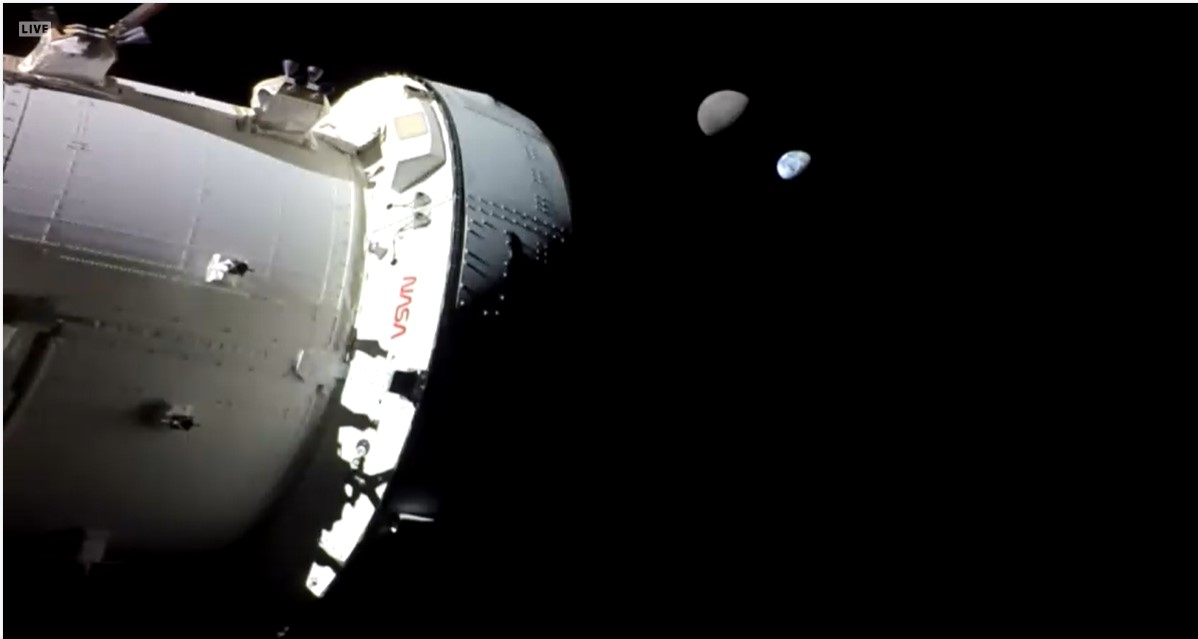

The Earth and Moon as see from the Orion spacecraft, close to 435,000 km (270,000 miles) from Earth. Credit: NASA livestream.
Artemis I is now on day seventeen of its mission, having just completed its distant retrograde orbit burn. This maneuver has placed the uncrewed Orion spacecraft (loaded with mannequins and sensors) on its way back to Earth. In honor of this historic mission that has traveled farther than any spacecraft in history, NASA has released a second supercut video of footage from the mission. The 1-minute, 36-second video includes highlights from the maiden launch of the Space Launch System (SLS) rocket and the Orion spacecraft making its circumlunar flight and looking back at the Earth-Moon system.
As NASA described in the description that accompanied the video’s release:
“Cameras on NASA’s Space Launch System (SLS) rocket and Orion spacecraft give us amazing views of our adventure around the Moon. See up close views of the Moon from external cameras as well as the view from inside the capsule.”
In the first minute, we see the launch, the separation of the solid rocket boosters, the launch abort system, and the second stage at various speeds (2x normal to close to 250x). We then see the Orion spacecraft deploying its four foldable solar arrays and snapshots of it floating through space and looking back at Earth. Next up, we see the Moon as Orion closes in on it, makes its closest approach and looks back to spot the lunar surface and Earth in the distance. Some snapshots from inside the spacecraft and many close-up pictures of the far side of the Moon (showing the cratered surface) follow.
The interior snapshots show the spacecraft connecting with the Callisto technology demonstrator that became active on Day Two of the mission (November 17th). The video closes with Orion’s most distant views of Earth and the Moon, which show just how far it has reached into deep space. These pieces of footage highlight the accomplishments of the mission and the importance of the spaceflight systems involved. They also underline what is special about the Artemis Program and the mission architecture that will send astronauts back to the Moon for the first time since the end of the Apollo Era.
“Orion is the only spacecraft capable of carrying humans from Earth on Artemis missions to deep space and bringing them back to Earth from the vicinity of the Moon,” NASA states. “SLS is the most powerful rocket in the world and the only rocket capable of launching Orion with astronauts and their supplies on Artemis missions to the Moon.”
Further Reading: NASA – Artemis I
The Habitable Zone is a central concept in our explorations for life outside the Earth.…
The Habitable Worlds Observatory, NASA’s planned successor to the James Webb Space Telescope, will be…
The asteroid belt beckons - it contains enough resources for humans to expand into the…
RCW 38 is a molecular cloud of ionized hydrogen (HII) roughly 5,500 light-years from Earth…
When astronomers detected the first known interstellar object, 'Oumuamua, in 2017, it sparked a host…
NASA continues to progress with the development of the Nancy Grace Roman Space Telescope (RST),…